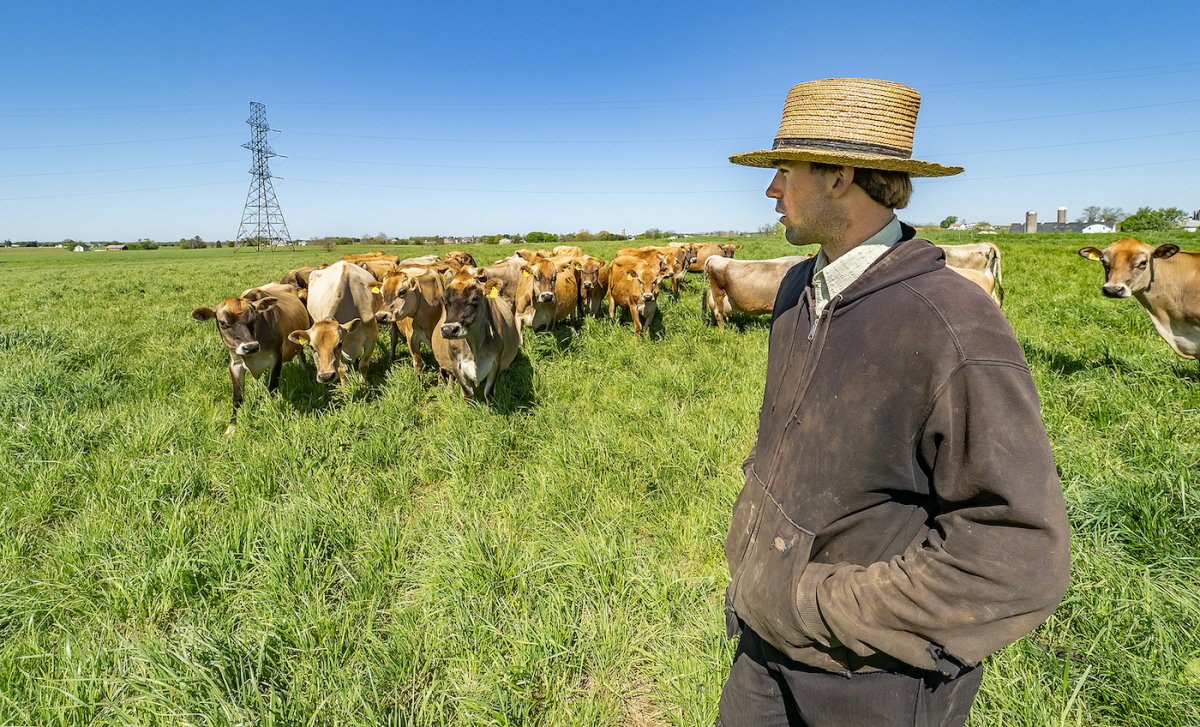Can a new organic milk line that relies on grazing, animal welfare, healthier cows, well-paid farmers and conservation practices help save both the Chesapeake Bay and struggling dairy farmers in Pennsylvania?
The multi-partner experiment known as the Dairy Grazing Project has launched in Lancaster, Lebanon, York and Dauphin counties. This area is a target of Pennsylvania's efforts to reduce agriculture-related nutrient pollution that not only fouls local streams but flows downstream to the Bay.
Funded in part by a three-year, $1 million grant from the National Fish and Wildlife Foundation, a coalition of eight nonprofits and private companies aims to persuade about 54 small dairies to switch to rotational grazing and a steady diet of grass for their cows.
By doing so, they hope to convert 6,000 acres of crop fields to pastures and plant perennial hay for winter cattle forage on another 4,000 acres that are currently dedicated to grain crops, which are prone to spawning polluted runoff.
That shift would reduce the amount of nutrients and sediment washed into waterways. Project managers estimate an annual reduction of 400,000 pounds of nitrogen, 9,000 pounds of phosphorus and 23 million pounds of sediment.
Project leaders also say that grazing at least 120 days a year on the land will save farmers money through reduced feed costs and healthier cows. At the same time, they content that grazing will enrich or regenerate the soil rather than deplete it through tillage and cropping.
A linchpin in the experiment is for about 40 of the 54 farmers to produce milk under a relatively new "Regenerative Organic Certification" registered by the Cleveland-based Origin Milk Co. The company says it will result in the country's first regenerative organic, grass-fed milk supply that contains only the A2 protein and not A1. A2 milk is favored by many with milk digestion problems.
The regenerative organic label expands the environmental and animal-health guarantees of current organic standards listed by the U.S. Department of Agriculture.
For a producer to earn the label, cows must be free to roam and slowly eat grasses by rotating through pastures. Being constrained in individual barn stalls at night and during winter is prohibited. Calves are not to be separated from their mothers. And bull calves cannot not be immediately slaughtered for meat.
New model
This effort is taking place in the heart of Pennsylvania's milk country, where pastures have long been retired in favor of growing feed and commodity crops. Dairy cows spend most of their time confined inside barns where they are fed grains and receive antibiotics and supplements designed to boost milk production.
Rotational grazing, advocates say, is an alternative with many benefits. A study by project partner Pasa Sustainable Agriculture found that pasture-grazed soils are even more fertile than ones that are not tilled, thanks in part to manure droppings and beneficial aeration by cow hooves.
The grasses and soil soak up carbon, a greenhouse gas. And cutbacks of synthetic fertilizers reduce emissions of nitrous oxides, a powerful greenhouse gas. That more than makes up for slightly higher emissions of methane gas from cow burps.
Also, the soil is more resilient in the face of extreme weather.
"This legacy industry is fraught with a bunch of issues. That needs to change. We want to start at the ground up with regenerative farming practices," said Adrian Boto, CEO and co-founder of Origin.
As an incentive, the company will pay qualifying farmers $40 per hundred pounds of milk to supply the new organic line. Currently, farmers are getting a little more than $30 per hundredweight for organic milk and $22–$24 for non-organic milk.
Long-term savings
On the surface, upending the dairy prototype seems to be a tough sell. Pennsylvania's plan to clean up its share of Bay pollution calls for converting 169,000 acres of farmland in the Bay drainage to rotational grazing, yet only 30,000 acres have been switched so far.
But project partners are banking on the willingness of financially strapped farmers to try something different. Grazing helps farmers save money by cutting down on commercial fertilizer, pesticides, planting equipment, seeds and feed supplements, they point out.
Leroy Miller, a Lancaster County Amish dairy farmer who switched from traditional crop and grain-fed dairy farming to grass-fed, rotational grazing in 2004, can vouch for that.
"My operating expenses are peanuts compared to what they used to be," said Miller, who grazes 35 Jersey dairy cows on a small 80-acre farm and sells various milk products at an on-farm market. He and his sons graze their cows 10 months a year and move grazing fences twice a day on average.
Regenerative dairy farming, he said, "just made sense for the whole ecosystem of how God designed the Earth for people to stay healthy."
While grass-fed cows produce less per milking than grain-fed cows, they tend to live longer and be healthier, requiring less veterinary care, studies show.
"There are grass-based dairies all over the country but here, if you are land limited, the allure of a great price per hundredweight is pretty strong because it may be the only way you can continue," said Sue Ellen Johnson, a pasture specialist with TeamAg, a consulting firm and partner.
Much of the early interest in the project has come from Plain Sect farmers, who are especially driven to remain in farming.
For the lure of reduced production costs and high milk premiums to work, consumers will have to accept higher prices for milk that protects the environment and farmers.
"It's about grassroots and letting consumers be a part of a movement. They will spend 10–20% more because they are part of a movement and not just buying a product," Origin's Boto said.
The Chesapeake Bay Foundation, which has championed regenerative grazing, applauds the project. "It is a big change and can't happen overnight. Farmers are used to riding a tractor and fertilizing corn," said Beth McGee, the group's director of science and agricultural policy.
Lucas Waybright of Pasa Sustainable Agriculture is convinced that a new breed of dairy grazing will resonate with consumers who increasingly want a holistic approach to farm products.
"You have a healthy cow, you're getting healthier land and you're getting a healthy business model because you are less dependent on conventional feeds. I think this is unlocking something significant. A cow in a pasture strikes something in humans."
Ad Crable is a Bay Journal staff writer based in Pennsylvania. Contact him at acrable@bayjournal.com. This article first appeared in the June 2022 issue of the Bay Journal and was distributed by the Bay Journal News Service.
Pennsylvania dairy-grazing project aims to save farmers, land, and Chesapeake Bay

Aaron Miller, a farmer in Lancaster County, Pa., stands in a grazing pasture with dairy cows. The family switched from traditional crop and grain-fed dairy farming to grass-fed rotational grazing in 2004. (Bay Journal Photo by Dave Harp)


